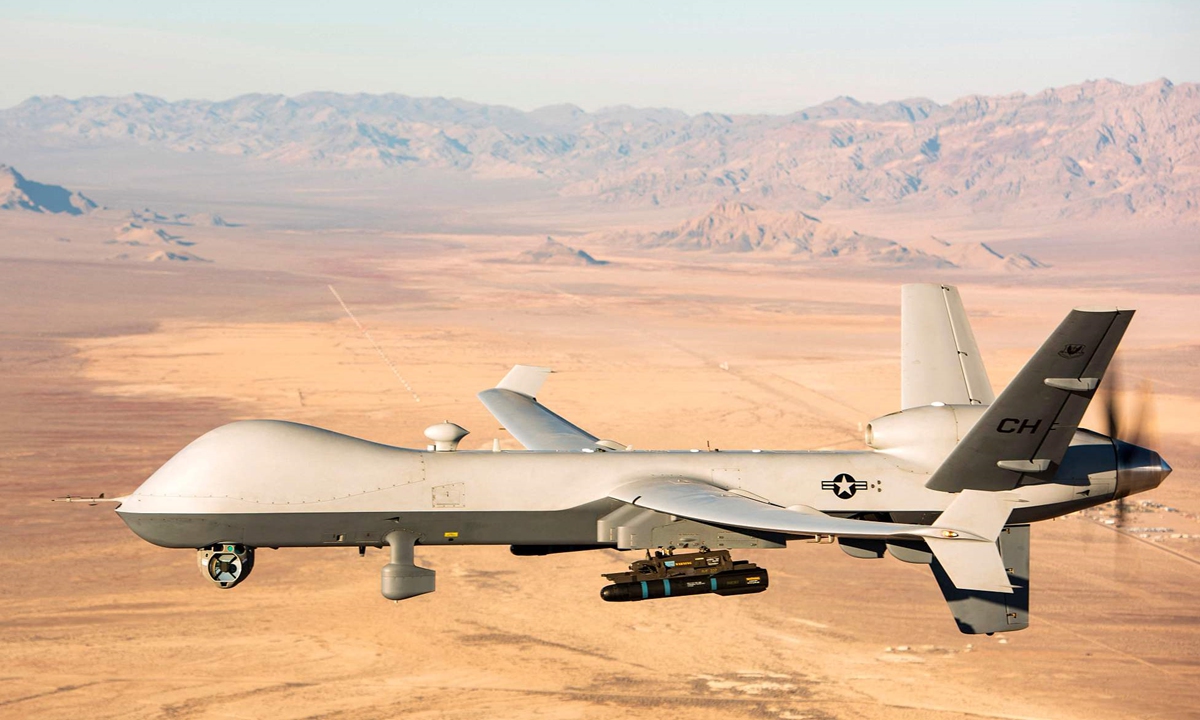
File photo of an MQ-9 Reaper drone. Photo: VCG
The incident of a Russian fighter jet allegedly colliding with a US drone has attracted global attention, with growing worries over increasing direct confrontation between Russia and the US over the Ukraine crisis. Analysts said the incident may not escalate as both the US and Russia do not want it to get out of control, but the risks of similar incidents may increase if the US keeps up its frequent and aggressive global reconnaissance globally.
The Pentagon on Tuesday claimed that two Russia Su-27 jets intercepted the MQ-9 "Reaper" drone in international airspace before one collided with it, causing the US spy drone to crash into the Black Sea, Reuters reported.
However, Russia's defense ministry denied that its aircraft had come into contact with the unmanned US aircraft, and said it crashed after "sharp maneuvering." Russia noted the drone was detected near the Crimea peninsula. Russia "had informed about this space that was identified as a zone for special military operation," media reported.
The incident marks the first time Russian and US military aircraft have come into direct physical contact since the Russia-Ukraine conflict started in 2022. Analysts said that the appearance of US drones in the Black Sea showcased the US military's deep involvement in the conflict and its frequent use of drones in collecting intelligence, and the risks of direct confrontations with Russia fighter jets had increased.
It is possible that the Russian fighter jets had electronic warfare pods and conducted electromagnetic interference, making the US drone lose control and activate its self-destruction program. Russia has identified this zone for its special military operation and it needs to take firm measures to deter the US, Song Zhongping, a Chinese military expert and TV commentator, told the Global Times.
The incident reflects that both the US and Russia are sounding out each side's bottom line, and after the interlude, they may gradually explore and set new tacit rules for flight and intercepts around the battlefield of the Russia-Ukraine conflict, said analysts.
They warned that the incident highlights the US' efforts in beefing up monitoring and information collecting with drones, especially toward countries it sees as rivals, which may lead to more direct confrontations and incidents and undermine global stability.
The US frequently sends drones including the MQ-4C to conduct close-in reconnaissance on China in the South China Sea, according to the monitoring of the South China Sea Strategic Situation Probing Initiative, a Beijing-based think tank.
Such US moves risk accidents just like the one in the Black Sea, analysts said.
The Chinese People's Liberation Army (PLA) takes professional, corresponding measures against the provocative US attempts should they threaten China's national security, including tracking, monitoring, escorting and expelling, experts said.
After the US shot down, with a fighter jet, an unmanned Chinese civilian airship that accidentally entered US airspace in early February, Senior Colonel Tan Kefei, a spokesperson at China's Ministry of National Defense, said that China will reserve the right to take necessary measures in dealing with similar situations.




